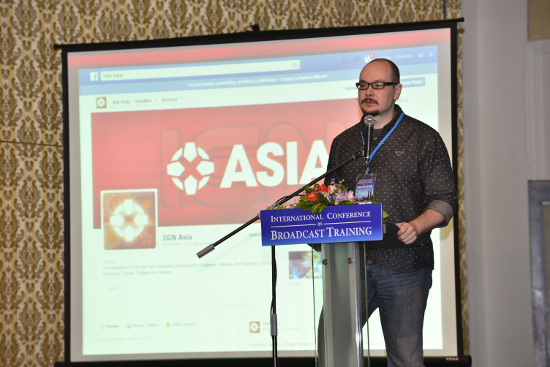Know your audience more.
Max Villandre, Publishing Director, IGN ASIA, Malaysia advised broadcasters to engage with their audiences, saying they have alienated themselves from viewers and listeners, and this may result in losing them more.
Know your audience more.
Max Villandre, Publishing Director, IGN ASIA, Malaysia advised broadcasters to engage with their audiences, saying they have alienated themselves from viewers and listeners, and this may result in losing them more.

“Know your audience more will influence how you deliver your products and services effectively,” he said.
Mr. Villandre spoke at the 2nd International Conference of Broadcast Training on 25 February 2014 in Kuala Lumpur, Malaysia.
In his presentation, he shared his company’s experience for the last 15 years of involving their community in several online platforms, freely allowing them to share content and engage with each other.
“Our website is free to anybody and the community we have built makes sure that no one misuses it. And those who regularly connect and interact with us receive some incentives,” he said.
Ms. Cosmalinda Simanjuntak, Programme Planning Manager, Televisi Republik Indonesia (TVRI) Training Centre, Indonesia, also spoke at the conference and said to adapt to the new realities in the media environment, broadcasters need to imbibe a new paradigm of learning that requires going back to the classroom to work out reinventing the organisation.

She said media organisations need to ensure that top executives must have a mindset change that supports new ways of training staff and adapting to the demands of the changing consumer behavior.
To date, TVRI’s business policy needs to be more relevant to the new media environment. It does not have a social media policy which is an urgent imperative given the increasing popularity of this platform,” she said.
Don’t Alienate Your Audience
Know your audience more.
Max Villandre, Publishing Director, IGN ASIA, Malaysia advised broadcasters to engage with their audiences, saying they have alienated themselves from viewers and listeners, and this may result in losing them more.
Media Who Connect to People Will Win
Dr. Joanne Lim Bee Yin, Deputy Director of the Centre for the Study of Communication and Culture, University of Nottingham, Malaysia, says in a networked world, media whose primary value lies in its ability to connect people will win and practitioners need to listen and connect more with them.
Increasing Social Media Use and Reach
The Korean Broadcasting System (KBS) is increasing its interaction with its audiences, no matter what devise they are utilizing, as one of three key strategies the organisation has employed to increase its social media use and reach. Two others include focusing on training and improving social media skills, and making social media a priority equal to its outreach strategies.
ICBT: Networking session
Day 2 - Tuesday, 25th February, 1400 - 1530
ICBT: Networking session
The session is exclusively devoted to provide opportunities for those participating for making direct contacts and interacting with those who have similar interests and issues in broadcast training to help build relations that will reap current or future benefits either individually or for collaborations for their broadcasting or training organisations.
ICBT: Session 4: Effective Curriculum Models for Social Media-Based Training
Day 2 - Tuesday, 24th February, 0900 - 1030
Session 4: Effective Curriculum Models for Social Media-Based Training
Curriculum models for Internet and social media-based education and training call for appropriate learning environment, content materials and educational instruction based on learning objectives and learner needs. These must include design principles and implementation strategies that require flexibility, diversity, participation and dialogue, fieldwork, and project demonstration. Can broadcasters in Asia-Pacific adopt a one-size-fit-all curriculum model to facilitate training and learning?
Optimising Social Media Use
Y.B Datuk Jailani Johari, Deputy Minister of Communications and Multimedia of Malaysia has called on broadcasters to evaluate critically the role of training in the new media environment that has impacted social change.
ICBT: Session 3: Training Tools for New Media and Social Media: Aiming for Depth and Efficiency
Day 2 - Tuesday, 24th February, 0900 - 1030
Session 3: Training Tools for New Media and Social Media: Aiming for Depth and Efficiency
ICBT: Session 2: Engagement and Collaboration: Taking Training to a Whole New Height (World Café Platform)
Day 1 - Monday, 24th February, 1400 - 1530
Session 2: Engagement and Collaboration: Taking Training to a Whole New Height (World Café Platform)
ICBT: Session 1: Innovations and Trends in New Media and Social Media for High Impact Training
Day 1 - Monday, 24th February, 1100 - 1230
Session 1: Innovations and Trends in New Media and Social Media for High Impact Training
Amidst continuous changes in the media environment, broadcasters are seeking new and leading methodologies to building human resource competencies. Conventional media training characterized by classroom style courses, passive rather than interactive approaches and single skill training may no longer be enough to deliver results. What are some cutting edge training tools and methodologies that will contribute to a more creative, productive and competitive workforce? Are online and social media methodologies better alternatives? How can these tools facilitate new ways to solve problems and generate creative and innovative ideas and solutions?





